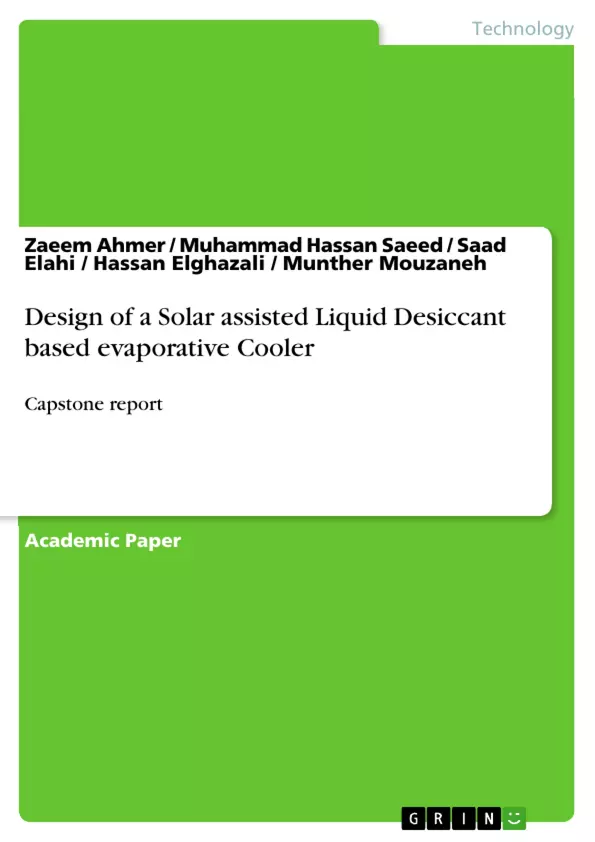The increase of occupant comfort demands are leading to rising requirement for air conditioning, but deteriorating global energy and environment crisis are starving for energy saving and environmental protection. The need to come up with the new energy saving as well as environmental friendly air conditioning systems has been more urgent than ever before. In hot and humid areas, the liquid desiccant air-conditioning systems based on evaporative cooling was proposed as a promising invention.
This system overcomes the difficulty of evaporative cooler increased humidity with cooling, which makes it unsuitable for hot and humid climates, by dehumidifying the air first and then cooling it inside an evaporative cooler with water. The heating effect of dehumidification process is compensated by cooling water circulation. The use of dehumidifier in conjunction with an evaporative cooler increases the efficiency of the system. Some of the advantages of using this system are: it can remove the air latent load, environmental friendly, removes the pollutants from the process air and reduces the amount of the electrical energy consumed.
The primary objective of this project is to design a solar based liquid desiccant evaporative system to purify and supply cool air. Liquid desiccant dehumidification has been proven to be an effective method to extract the moisture of air with relatively less energy consumption, especially compared with conventional vapor compression system. Inside the dehumidifier we used calcium chloride solution which after some period of time gets diluted with water and loses its moisture absorbing capacity and therefore, needs to be heated in the solar collector to ensure that the liquid desiccant does not lose its absorption capacity.
In this project, several different aspects in solar assisted liquid desiccant based evaporative cooler have been considered. Some of these aspects include the availability of the materials, manufacturability of the product, sustainability of the product, health and safety regulations and the environmental effects of the product.
Inhaltsverzeichnis (Table of Contents)
- ABSTRACT
- LIST OF FIGURES
- LIST OF TABLES
- LIST OF SYMBOLS and ABBREVIATIONS
- CHAPTER 1 - INTRODUCTION
- 1.1. Detailed definition of the project
- 1.1.1 Conventional Evaporative Cooling Systems
- 1.1.2 Desiccant Material
- 1.1.3 Different Type of Desiccants
- 1.1.4 Desiccant Cooling System
- 1.1.5 Desiccant Dehumidification
- 1.1.6 Desiccant Based Evaporative Cooling
- 1.2. Significance of the project
- 1.3. Detailed project objectives
- 1.4. Detailed project constraints
- 1.5. Report Organization
- CHAPTER 2 - LITERATURE REVIEW
- 2.1. Background information
- 2.1.1 Liquid Desiccant Dehumidification for Solar Cooling
- 2.1.2 Hybrid Solar Liquid desiccant and Evaporative Cooling Systems
- 2.2. Concurrent solutions
- 2.3. Comparisons of the concurrent solutions
- 2.4. Engineering standards of the concurrent solutions
- CHAPTER 3 -DESIGN and ANALYSIS
- 3.1. Proposed/Selected design
- 3.2. Engineering standards
- 3.3. Design calculations
- 3.3.1 Solar Collector
- 3.3.2 Desiccant Dehumidifier
- 3.3.3 Pump Calculations
- 3.3.4 Evaporative Cooler
- 3.4. Cost analysis
- CHAPTER 4 – MANUFACTURING PLAN
- 4.1. Manufacturing process selection
- 4.1.1 Material Selection
- 4.1.2 Cost of the Manufacturing Process
- 4.1.3 Properties and characteristics of product
- 4.2. Detailed manufacturing process
- CHAPTER 5 - PRODUCT TESTING PLAN
- 5.1. Verification plan of the objectives of the project
- REFERENCES
- APPENDIX A: Electronic Media
- APPENDIX B: Constraints
- APPENDIX C: Standards
- APPENDIX D: Logbook
- APPENDIX E: Project Timeline
- APPENDIX F: Engineering Drawings
Zielsetzung und Themenschwerpunkte (Objectives and Key Themes)
This project aims to design a solar-powered liquid desiccant evaporative cooling system for purifying and supplying cool air. The project focuses on developing a cost-effective and environmentally friendly solution for air conditioning in hot and humid climates. The system utilizes a desiccant to remove moisture from the air, followed by evaporative cooling to reduce the temperature. This approach offers a potential solution for reducing energy consumption and environmental impact compared to conventional vapor compression systems.
- Development of a solar-powered desiccant evaporative cooling system
- Utilization of liquid desiccants for efficient moisture removal
- Integration of solar energy for sustainable operation
- Evaluation of system performance and cost effectiveness
- Environmental impact assessment of the system
Zusammenfassung der Kapitel (Chapter Summaries)
Chapter 1: Introduction provides a comprehensive overview of the project, including a definition of the project, its significance, objectives, and constraints. It delves into conventional evaporative cooling systems, different types of desiccants, and the working principle of desiccant cooling systems.
Chapter 2: Literature Review presents a thorough examination of existing research and technologies related to liquid desiccant dehumidification and hybrid solar liquid desiccant evaporative cooling systems. It analyzes concurrent solutions and compares their engineering standards.
Chapter 3: Design and Analysis focuses on the proposed design of the system, including detailed engineering standards and calculations for components such as the solar collector, desiccant dehumidifier, pumps, and evaporative cooler. It also examines cost analysis of the system.
Chapter 4: Manufacturing Plan outlines the manufacturing process selection, material selection, cost of the manufacturing process, properties and characteristics of the product, and detailed manufacturing process.
Chapter 5: Product Testing Plan focuses on the verification plan for the project's objectives.
Schlüsselwörter (Keywords)
The project revolves around the concept of a solar-powered liquid desiccant evaporative cooling system. Key terms include: desiccant dehumidification, evaporative cooling, solar energy, energy efficiency, environmental sustainability, cost-effectiveness, and hot and humid climates. The project incorporates calcium chloride as the desiccant material, with the system design and performance analysis being central to the research.
- Citation du texte
- Zaeem Ahmer (Auteur), Muhammad Hassan Saeed (Auteur), Saad Elahi (Auteur), Hassan Elghazali (Auteur), Munther Mouzaneh (Auteur), 2017, Design of a Solar assisted Liquid Desiccant based evaporative Cooler, Munich, GRIN Verlag, https://www.grin.com/document/385089



